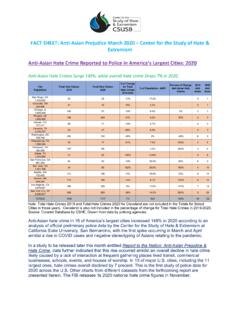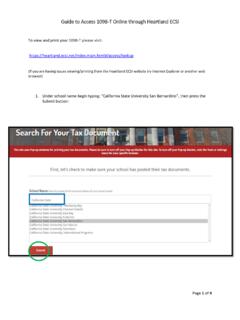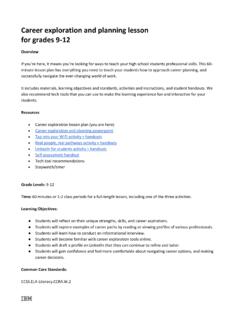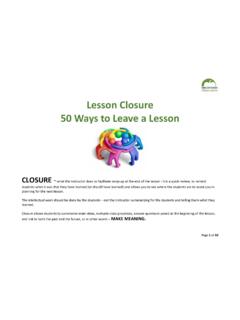Transcription of Lesson 2: Geographical Features
1 Standard Exploring the Landscape of San Diego 9 Lesson 2: Geographical Features Focus Question: What are the Geographical Features of a place? Activity #1 Physical Features Materials needed: For each student, a copy of Lesson Structure: Previewing the Organization of a Lesson (Handout # ) or Scavenger Hunt (Handout # ). Harcourt s Reflections: Our Communities Lesson 2 Physical Features pages 16-21 (Note: Although reference is made to specific page numbers in Harcourt s Reflection, the same activities and strategies may be completed using any of the state-adopted social studies textbooks.) Procedure: Step 1: Explain to students that a place may be described by telling about its physical Features its land, water, climate and plants. Physical Features are sometimes called Geographical Features .
2 To describe the Geographical Features of a place, you might talk about its landforms. Before humans ever settled here, landforms were shaped by nature. The land is still changing today, but most change is too slow for us to see (except for landslides, floods, earthquakes, fires or other such events seen on the news). Step 2: Preview Lesson 2 Physical Features (Harcourt s Reflections: Our Communities pages 16-21). To preview the Lesson , use the same procedure described in Lesson 1. Help students complete Lesson Structure: Previewing the Organization of a Lesson (Handout # ) or Scavenger Hunt (Handout # ). Note: The focus of Lesson 2 is on the physical Features of California. Our major focus will be on the Features of San Diego. Discuss which Features in the Lesson are found in the San Diego area.
3 Step 3: Refer to Geography Terms on textbook page I-14. Focus on pertinent local landforms including island, lake, mountain, ocean, river, and valley. Have students check the Glossary (page R35) for a definition of bay. Discuss the meaning of the words beach, canyon, ravine and other pertinent landforms in your area. Activity #2 Geographical Terms and Definitions Match-Up Materials needed for each student: For each student, a copy of Geographical Feature Terms (Handout ) and Definitions of Geographical Features (Handout ); a sheet of 12 x18 construction paper, scissors and glue. Procedure: Step 1 Cut and Sort: Distribute copies of Geographical Feature Terms (Handout # ) and Definitions of Geographical Features (Handout # ). Have students cut out each Geographical feature term and the definitions of Geographical Features .
4 Students work individually or in pairs to match each Geographical feature term with its definition. Step 2 Match the Term: The teacher reads each definition from Definitions of Geographical Features (Handout # ) as each student holds up the card with the matching geographic term. The teacher checks for accuracy. (Optional) As you read each definition, display photographs of local landforms for each Geographical term. Standard Exploring the Landscape of San Diego 10 Step 3 Tic-Tac-Toe: Have each student randomly arrange the 9 geography word cards in a 3 by 3 grid on his/her desk. As you read a definition, the student turns over his/her matching vocabulary card. When a student turns over 3 in a row vertically, horizontally, or diagonally, he/she calls out Tic-Tac-Toe). Verify by having the student read his/her terms aloud.
5 Continue to play for blackout (all 9 cards are turned over). Repeat as many times as desired. Students may rearrange cards for each round. Step 4 Geography Guessing Game: Tape or clip a Geographical term word card Geographical Feature Terms (Handout # ) on the backs of different students. Students walk around the room and try to guess what term is on their back by asking their classmates questions that require a yes or no answer. When the term is guessed, the student may place the card on the front of his/her shirt and assist the remaining students by answering their questions. Have Definitions of Geographical Features (Handout # ) available for student reference. Step 5 Geographic Terms and Definitions Match-Up: On a sheet of 12 x18 construction paper, students paste each geographic term together with its matching definition.
6 Save the Geography Match-Ups to include in the Atlas of San Diego assembled at the end of the unit. Activity #3 Using Maps to Find Geographical Features of San Diego Using different maps of the local region ( AAA map of San Diego), have students work in pairs or small groups to look for specific names of Geographical Features found in the San Diego area. Students neatly record the full name of each feature on their chart, Right Here in San Diego (Handout # ). See the chart listed below for a sample of responses. Have students share their results. Right Here in San Diego Geographical Features Examples from the San Diego Map mountain Cowles Mountain, Otay Mountain river Tijuana River, Sweetwater River valley Mission Valley island Harbor Island ocean Pacific Ocean bay San Diego Bay, Mission Bay Assessment: Assessment of this Lesson is integrated with the instruction and occurs throughout the Lesson .
7 The focus question provides a framework for the evaluation of the Lesson . Student work to be assessed includes: Previewing the Organization of a Lesson (Handout # ) or Scavenger Hunt (Handout # ). Geographical Terms and Definitions Match-Up (Activity 2) It is recommended you save the Match-Up for inclusion in the unit project, Atlas of San Diego. Students work in pairs or small groups to complete Right Here in San Diego (Activity 3). Standard Exploring the Landscape of San Diego 11 The following Extended Activities are optional extensions for this Lesson . (Optional) Begin the Climate Weather Log described Climate of San Diego - a Daily Weather Log (Handout # ). (Optional) English Language Learner Extension: Landforms of San Diego A Booklet or Banner Student-generated visuals aid the learning and retention of specialized vocabulary terms.
8 To provide a visual representation of the geography terms used in this Lesson , it is recommended that the teacher or the students create a picture file of geographic Features in the local region. For example, using Geographical terms such as those listed in Geographical Feature Terms (Handout # ), have students create a booklet with a page or pages that includes pictures or photographs of landforms found in the San Diego region. Students can collect illustrations of landforms from magazine pictures, travel posters, postcards, family vacation photos, art prints or calendar prints of landscapes. Or, students can take photographs of different Geographical Features of the San Diego region. A local map can be included with markers showing where the photos were taken. Students select and label the pictures and assemble them into a booklet, Landforms of the San Diego Region.
9 Or, display them on a banner as shown at the right. Include the booklet or banner as a part of the student s Atlas of San Diego to be compiled at the end of the unit. As an alternative, include the illustrations and photographs on a classroom bulletin board labeled, Landforms of San Diego. (Optional) Geography Extension Activity: Map an Imaginary Place Each student selects at least ten Geographical Features to include in a physical map of an imaginary place. The Geographical Features selected need not be the same as the ones found in the San Diego region. For example, a student may include an island, a beach, a peninsula and a river as part of the Geographical Features to be found at their imaginary place. The map should be drawn on construction paper with crayons or colored pencils. The Map of Imaginary Place should include: map title with the name of the imaginary place a compass rose at least 10 Geographical Features labeled with names a legend or key to identify symbols a written description of where the imaginary land is located and information about its natural environment including the land forms, bodies of water, soil and how people have changed or modified the physical environment over time.
10 Standard Exploring the Landscape of San Diego 12 Handout # Geographical Feature Terms mountain lake island ocean river valley bay canyon beach Standard Exploring the Landscape of San Diego 13 Handout # Definitions of Geographical Features a body of salt water that covers a large area; larger than a sea the shore of a body of water, especially when sandy or pebbly; the sandy or rocky land at the edge of an ocean, sea, or lake. a landform with water all around it; a piece of land that is smaller than a continent and completely surrounded by water a body of water that is part of a sea, ocean or lake and is partly enclosed by dry land low land between hills or mountains; a gently sloping depression between hills or mountains a body of water with land on all sides; a large inland body of water the highest kind of land; a rugged, upthrust mass of rock that looms high above the surrounding land a deep, narrow valley with steep rocky sides.













